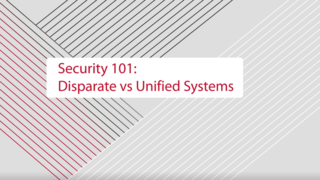Security 101: Disparate vs. Unified Systems
By Northland Controls, Sep 14, 2021

Global Director of Design and Consulting, Danny Chung, speaks to the challenges of using a disparate system and how transitioning to a unified system can be a game-changer for your overall security team.
As companies grow and evolve over time, system continuity often falls to the wayside. With more employees, added office locations, and diverse business groups, new systems continue to be introduced with little regard to how they coincide with what is already in place. Once that mindset gains momentum, wide-reaching disparate systems can create a variety of challenges including data inaccuracy, wasted time and resources, and other inefficiencies.
At their core, disparate systems make it difficult to collect data from badging and card holder systems as well as other key business platforms across multiple locations. As a result, these systems act as a silo, unable to share information due to incompatibility with other data sources throughout the company. Because this information is not compiled in one single location, security teams are forced to search through various platforms to collect, manage, and analyze data sets, wasting valuable time and key resources. In many instances, outdated legacy systems tend to be the root of the problem.
When data is difficult to manage, security teams become limited in their ability to see their kingdom in its entirety. This becomes particularly challenging when companies are faced with a potential threat to their people and assets. While there are many critical event management systems that help to manage these threats, disparate system makes it difficult to integrate into a single response platform. For example, think about how much more difficult it would be to locate your employees and ensure their safety if their location is a buried in an unconnected access control system. When time is of the essence, a delayed notification for employees in affected areas can lead to life-threatening situations.
Taking a unified approach can be a game-changer for security teams but many are hesitant to make the transition. Danny Chung, Northland Control’s Global Director of Design and Consulting, says that the most common reason for this hesitation is the cost. However, he goes on to say that “when you look at the return on investment and the benefits of unifying those systems, it’s going to be a real game changer for your security teams.” Spreading out the cost over five to ten years will help realize the true return on investment and help to justify the inbound expense.
Once unified, platforms can better support business goals and day to day operations. According to Chung, teams will see better data and enhanced response to critical events due to streamlined access to important information. Because it is easier to pull data from one unified source instead of a variety of sources throughout the company, and sometimes throughout the world, breaking down the silos so that systems can easily integrate and communicate with one another will have a significant impact.
While security departments are often seen as cost centers, a unified system provides an opportunity for them to present actionable business insights to management in order to inform smarter business decisions. Just a few examples of this include data pertaining to space planning, HVAC system utilization, and office density, something particularly important as companies’ welcome employees back into the office.
Northland Controls’ Design and Consulting team has years of experience supporting companies through system migrations for a more unified and systematic approach. Let us know if we can provide more information on the benefits of a unified system or on how to get started dismantling your disparate systems by emailing info@northlandcontrols.com.